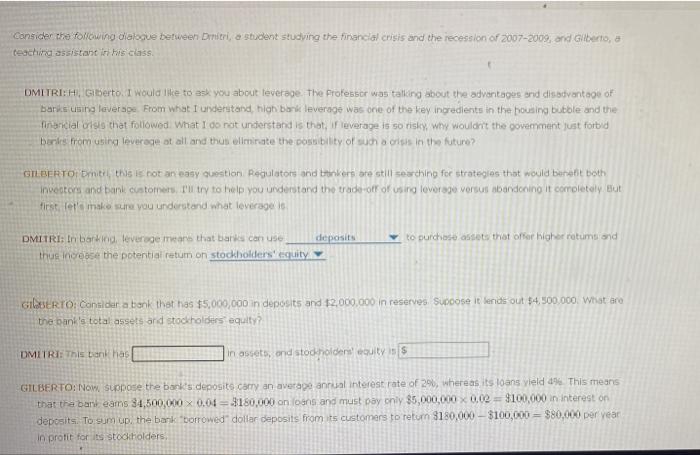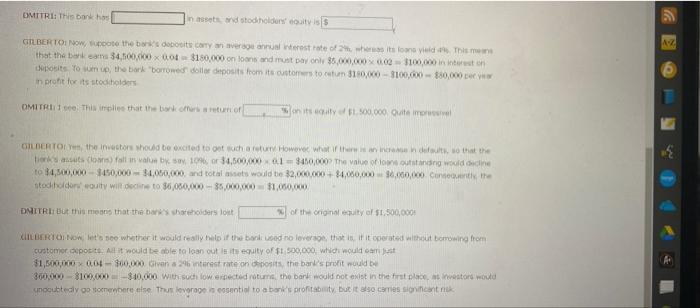Answered step by step
Verified Expert Solution
Question
1 Approved Answer
Gilberto: consider a bank that has $5 million in deposits and $2 million in reserves. Suppose it lends out $4,500,000. What are the banks total


Gilberto: consider a bank that has $5 million in deposits and $2 million in reserves. Suppose it lends out $4,500,000. What are the banks total assets and stockholders equity?
Consider the following dialogue between Dmitri, a student studying the financial crisis and the recession of 2007-2009, and Gilberto, a teaching assistant in his class. DMITRI: HI, Giberto. I would like to ask you about leverage. The Professor was talking about the advantages and disadvantage of banks using leverage. From what I understand, high bank leverage was one of the key ingredients in the housing bubble and the financial crisis that followed. What I do not understand is that, if leverage is so risky, why wouldn't the government just forbid banks from using leverage at all and thus eliminate the possibility of such a crisis in the future? GILBERTO: Dmitr, this is not an easy question Regulators and bankers are still searching for strategies that would benefit both investors and bank customers. I'll try to help you understand the trade-off of using leverage versus abandoning it completely. But first, let's make sure you understand what leverage is deposits to purchase assets that offer higher retums and DMITRI: In banking, leverage means that barks can use thus increase the potential retum on stockholders' equity GILBERTO: Consider a bank that has $5,000,000 in deposits and $2,000,000 in reserves Suppose it lends out $4,500,000. What are the bank's total assets and stockholders equity? DMITRI: This bank has in assets, and stockholders' equity is S GILBERTO: Now suppose the bank's deposits carry an average annual interest rate of 2%, whereas its loans vield 4%. This means that the bank ears $4,500,000x 0.04-3180,000 on loans and must pay only $5,000,000 0.02 $100,000 in interest on deposits. To sum up, the bank "borrowed dollar deposits from its customers to return $180,000-$100,000 $80,000 per year in profit for its stockholders, DMITRI: This bank has in assets, and stockholders' equity is S GILBERTO: Now, suppose the bank's deposits carry an average annual interest rate of 2%, whereas its loans yield as. This means that the bank eams $4,500,000 0.04 $180,000 on loans and must pay only $5,000,000 0.02 $100,000 in interest on diposits. To sum up, the bark "borrowed dollar deposits from its customers to return $180,000-3100,000-$80,000 per year in profit for its stockholders OMITRI: 1 see. This implies that the bank offers a return of on its equity of $1,500,000, Quite impressivel GILBERTO Yes, the investors should be excited to get such a return However what if there is an increase in defaults, so that the bonk's assuts Cloans) fall in value by say, 10%, or $4,500,00001$450,000 The value of loans outstanding would decline to $4,500,000-$450,000 $4,050,000, and total assets would be $2,000,000+ $4,050,000 $6,000,000. Consequently, the stod holders equity will decline to 36,050,000-$5,000,000 $1,050,000 DMITRI: But this means that the bank's shareholders lost % of the original equity of $1,500,000 GILBERTO Now, let's see whether it would really help if the bank used no leverage, that is, if it operated without borrowing from customer deposits. All it would be able to loan out is its equity of $1,500,000, which would eam just $1,500,000 004-300,000 Given a 296 interest rate on deposits, the bank's profit would be 300,000-$100,000-$40,000 with such low expected returns, the bank would not exist in the first place, as investors would undoubtedly go somewhere else. Thus leverage is essential to a bank's profitability, but it also camies significant risk A-Z A Dmitri: this bank has____ in assets, abd stockholders equity is $____
Gilberto: now suppose the banks deposits carry an average annual interest rate of 2% whereas its loans yield 4%. This means that the bank earns $4,500,000 x 0.04 = $180,000 on loans and must pay only $5 million x 0.02 = $100,000 in interest on deposit. To sum up, the bank "
borrowed" the dollar deposits from its customers to return $180,000 -$100,000 = $80,000 per year in profit for its stockholders.
Dmitri: I see. This implies that the bank offers a return of ____% on its equity of $1,500,000. Quite impressive!
Gilberto: yes, the investors should be excited to get such a return! However, what if there is an increase in defaults, so that the banks assets fall in value by, say, 10%, or $4,500,000 x 0.1 = $450,000? The value of loans outstanding with decline to $4,500,000 -$450,000 = $4,050,000 and the total assets would be $2 million + $4,050,000 = $6,050,000. consequently, the stockholders equity will decline to $6,050,000 -$5 million = $1,050,000.
Dmitri: but this means that the banks shareholders lost ____% of the original equity of $1,500,000!
Gilberto: now let's see whether it would really help if the bank used no leverage, that is, if it operated without borrowing from customer deposits. All it would be able to loan out is its equity of $1,500,000 which would earn just $1,500,000 x 0.04 = $60,000. given a 2% interest rate on deposits, the banks profit would be $60,000 -$100,000 = -$40,000. with such low expected returns, the bank would not exist in the first place, as investors would undoubtedly go somewhere else. Thus leverage is essential to a banks profitability, but it also carries significant risk.
Step by Step Solution
There are 3 Steps involved in it
Step: 1

Get Instant Access to Expert-Tailored Solutions
See step-by-step solutions with expert insights and AI powered tools for academic success
Step: 2

Step: 3

Ace Your Homework with AI
Get the answers you need in no time with our AI-driven, step-by-step assistance
Get Started


